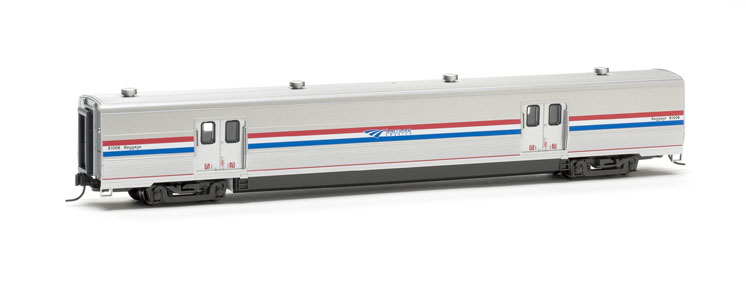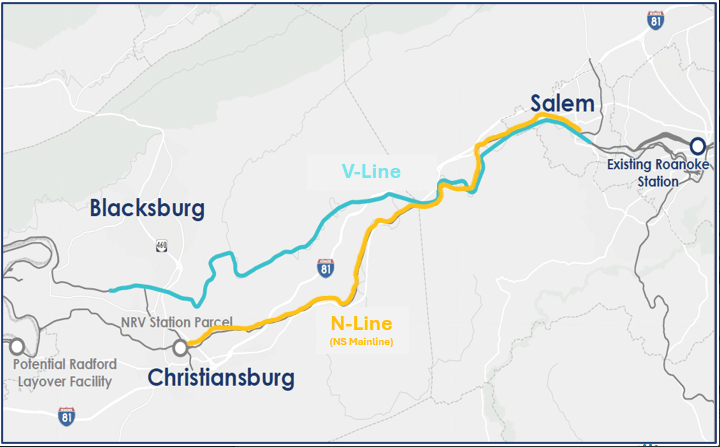If you like to keep up with the cutting edge of rail passenger equipment, Kato has a deal for N scale modelers. Viewliner II baggage cars are now on hobby shop shelves, hot on the heels of their recently delivered prototypes.
The prototype: The Viewliner II is the first new baggage car for mainline passenger service in the United States since the 1960s.
All of Amtrak’s former baggage cars were built for the railroads whose passenger service Amtrak took over with its formation in 1971. By the 21st century, the baggage fleet consisted of half-century-old cars that suffered from leaky doors that allowed parcels and passengers’ baggage to get wet, obsolete wheelsets and brake systems, analog electronics, and aging carbodies built by defunct manufacturers.
The new baggage cars were built by CAF USA, the U.S. subsidiary of Spanish carbuilder Construcciones y Auxiliar de Ferrocarriles under a 2010 order for 130 cars. The order, worth $298.1 million, originally called for 55 baggage cars, 25 dining cars, 25 sleepers, and 25 baggage-dormitory cars. Amtrak swapped 15 baggage-dormitory cars for straight baggage cars to keep production lines moving at one point, bringing the baggage car total to 70. Workers in Elmira, N.Y. built the cars of largely U.S. components.
The cars follow the design of the Viewliner sleepers Amtrak had built for use on Northeast Corridor trains. While the other Viewliner II cars are intended for service in the tight quarters of the Northeast, the baggage cars are being used nationwide. They feature racks for passengers’ bicycles, a gun safe, and a climate-controlled area for carrying pets in the event Amtrak offers that service.
The stainless steel cars are nominally 85 feet long and ride on GSI-type trucks. The first cars entered service in 2015. The last cars of the 70-unit order were delivered in 2017.
Kato’s model. The Viewliner II baggage car has a molded plastic shell that snaps onto a plastic frame. Most of the details, including all of the handrails and grab irons, are molded on the shell. Four rooftop ventilators and solid diaphragms around the end doors are the major added detail parts. The roof panel is also a separate piece.
The windows in all of the doors are clear plastic inserts with rubber gasket detail painted on. Marker lights at both ends are opaque red plastic. Although there is provision for power pickup on the trucks and underframe, adding operating marker lights would require replacing the opaque inserts.
The underframe is a one-piece plastic molding. Ladders for the baggage doors are molded into the casting, along with the access panels covering the underfloor equipment. The bottom of the car is smooth. Kato knuckle couplers are mounted at the correct height to the GSI-type trucks. The trucks snap into the floor.
The trucks have blackened metal wheels inserted into black plastic axles. Wipers on the tips of the wheels contact metal strips trapped between the floor underframe castings.
Kato offers a lighting kit, no. 11-211, designed to fit all its passenger cars. The interior is bare with the exception of posts for mounting the lighting kit. A metal weight sits in the bottom of the underframe. The car weighs 1.2 ounces, .2 ounce less than National Model Railroad Association Recommended Practice 20.1.
I couldn’t find published drawings of the Viewliner II baggage car, but Kato confirmed the model was based on prototype drawings provided by Amtrak. The Kato car measures scale 84′-4″ from diaphragm to diaphragm. The trucks, with 8′-6″ wheelbases, are mounted on 59′-3″ centers. The overall height is 14′-6″ and the overall width is 10′-3″.
The model is painted silver with an appropriate sheen for a stainless steel car that’s been in service for a little while. The Phase III striping with its modern Amtrak logo is sharp and opaque. The labels on the doors capture the shape of their Amtrak counterparts, but are too small to read clearly. The underframe and trucks are molded in dark gray plastic that appears close to the color on Amtrak equipment.
I tested the cars on our Red Oak N scale project layout. The cars had no trouble negotiating the layout’s 13″ radius curves and Peco no. 6 medium turnouts. The truck-mounted Kato couplers helped the baggage cars track well through crossovers.
For Amtrak, it was a long wait to get new baggage cars. For N scale modelers, the wait hasn’t been long at all. With Kato’s thoughtful engineering, these Viewliner II baggage cars will likely give excellent service for years to come.
Manufacturer
Kato USA
100 Remington Rd.
Schaumburg, IL 60173
www.katousa.com
Era: 2015-present
Road names: Amtrak, two road numbers
Features
• Blackened metal wheelsets, in gauge
• Kato knuckle couplers, at correct height














